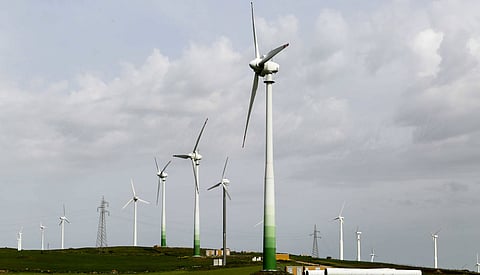Wind energy's prospects are blowin’ in the wind
A tender issued by the Solar Energy Corporation India (SECI) last fortnight has set the cat among the pigeons in the country’s wind energy players. The tranche XI tender, for the setting up of a 1,200MW interstate transmission system (ISTS), says the power SECI procures from the ISTS-connected wind power projects will be sold to the distribution companies (DISCOMs) of Madhya Pradesh.
And there lies the nub: the state in which the power is generated gets hardly any return, while the one receiving it – in this case, the Madhya Pradesh Power Management Company Limited (MPPMCL) – will laugh all the way to the bank.
The entire power sector, according to a note by Powerica Ltd, is reeling under extreme pressure since March 2020 when the devastating Covid-19 pandemic hit the world. “Not only the execution of under-construction wind power projects has stalled, the reduced demand of electricity from commercial and industrial consumers quenched the appetite of the DISCOMs to invite future bids,” says company director Pradeep Gupta.
While Powerica owns and operates IPP (independent power producer) wind assets totalling 253MW, with another 50 MW under construction, not a single substantial wind energy auction was concluded during the lacklustre year, he points out. “The developers’ response and the outcome of SECI’s tranche X wind auction came as a relief, getting oversubscribed and receiving bids for 3.15 GW of projects from 11 developers. This is a positive sign for the industry.”
LM Wind Power, which is a world-leading designer and manufacturer of rotor blades for wind turbines, has stepped up exports from its two Indian facilities at Dabaspet in Karnataka and Halol in Gujarat to nearly 70 per cent of production. LM manufactured over 3,500 blades in 2020. The Denmark-headquartered company also became the first carbon-neutral business in 2018.
Other players have tripped on the way, failing for different reasons. While Siemens Gamesa has wound up operations, Indian wind energy pioneerTulsi Tanti's Suzlon went in for debt restructuring and is bouncing back.
Dr PKC Bose, vice chairman and managing director of Enercon Windenergy, on the other hand, tremendous potential in India. “We see opportunities where others see threats,” he says. “Enercon is the only company that has boldly announced plans for growth.”
“While the must-run status helps the RE (renewable energy) projects not to face any curtailment on account of weak demand during the pandemic, chronic issues like payment delay from DISCOMs and grid constraints are adding continuously to the investors’ woes,” Powerica’s Gupta says. “The recent change in weather pattern due to climate change is evolving to be a major challenge for the operational projects. The frequent occurrence of extreme weather conditions like cyclonic storms, as well as heavy precipitation and flood, not only damage the equipment but also dampen the resource availability (wind speed and solar radiation) drastically, causing a huge loss of generation and hence revenue.”
Other experts, too, point out that lockdowns, other restrictions and rains have caused electricity demand to dip, especially with the Taukate and Yaas cyclones hit the the west and east coasts, respectively. The country doesn’t seem to be poised to recover from this dip in the near future.
Danfoss, which helps lower the cost of energy with customised power electronics, specialises in power modules, thermal management, manufacturing and testing of power conversion equipment that helps to efficiently harness wind power, according to its India president Ravichandran Purushothaman. Through a wide range of products and technologies, the company helps in deriving the most from the wind turbine generator and reducing the cost of power conversion.
With wind turbines often operating 24/7 and exposed to extreme weather conditions, leading to ‘enormous’ wear and tear, it is vital to prevent expensive breakdowns. Danfoss ensures the optimisation of wind turbines and power converters with its ‘Power Stack’, a high-quality power conversion assembly, which is the main building block in any power conversion system. Each customer needs its own individually-designed product, he adds.
Overall, the sector hopes that the sluggishness in electricity demand caused by the pandemic will reboot it to start it afresh where all the future capacity addition could be planned with zero contribution from fossil fuel. Though a complete switchover from thermal dependency is a distance future, multiple RE resources can co-exist and complement one another.
Wind energy major Suzlon has not wound up operation as mentioned in the earlier version. In fact the company has bounced back.
(Updated on 15-06-2021)

